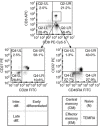Excess body mass is associated with T cell differentiation indicative of immune ageing in children
- PMID: 24401077
- PMCID: PMC3992037
- DOI: 10.1111/cei.12267
Excess body mass is associated with T cell differentiation indicative of immune ageing in children
Abstract
Obesity has been associated with accelerated biological ageing and immunosenescence. As the prevalence of childhood obesity is increasing, we wanted to determine if associations between obesity and immunosenescence would manifest in children. We studied 123 Mexican American adolescents aged 10-14 (mean 12·3 ± 0·7) years, with body weights ranging from 30·1 to 115·2 kg (mean 52·5 ± 14·5 kg). Blood samples were obtained to determine proportions of naive, central memory (CM), effector memory (EM), senescent and early, intermediate and highly differentiated subsets of CD4(+) and CD8(+) T cells. Overweight and obese children had significantly lowered proportions of early CD8(+) T cells (B = -11·55 and -5·51%, respectively) compared to healthy weight. Overweight children also had more EM (B = +7·53%), late (B = +8·90%) and senescent (B = +4·86%) CD8(+) T cells than healthy weight children, while obese children had more intermediate CD8(+) (B = +4·59%), EM CD8(+) (B = +5·49%), late CD4(+) (B = +2·01%) and senescent CD4(+) (B = +0·98%) T cells compared to healthy weight children. These findings withstood adjustment for potentially confounding variables, including age, gender and latent cytomegalovirus and Epstein-Barr virus infections. We conclude that excess body mass, even in adolescence, may accelerate immunosenescence and predispose children to increased risks of incurring immune-related health problems in adulthood.
Keywords: adolescents; herpes viruses; immunosenescence; obesity; overweight.
© 2014 British Society for Immunology.
Figures


Similar articles
-
Persistent skewing of the T-cell profile in adolescents adopted internationally from institutional care.Brain Behav Immun. 2019 Mar;77:168-177. doi: 10.1016/j.bbi.2019.01.001. Epub 2019 Jan 9. Brain Behav Immun. 2019. PMID: 30639443 Free PMC article.
-
The impact of 6-month training preparation for an Ironman triathlon on the proportions of naïve, memory and senescent T cells in resting blood.Eur J Appl Physiol. 2012 Aug;112(8):2989-98. doi: 10.1007/s00421-011-2273-9. Epub 2011 Dec 15. Eur J Appl Physiol. 2012. PMID: 22170013
-
Aerobic fitness is associated with lower proportions of senescent blood T-cells in man.Brain Behav Immun. 2011 Nov;25(8):1521-9. doi: 10.1016/j.bbi.2011.07.226. Epub 2011 Jul 19. Brain Behav Immun. 2011. PMID: 21784146
-
Replicative senescence: the final stage of memory T cell differentiation?Curr HIV Res. 2003 Apr;1(2):153-65. doi: 10.2174/1570162033485348. Curr HIV Res. 2003. PMID: 15043200 Review.
-
Telomere Dynamics in Immune Senescence and Exhaustion Triggered by Chronic Viral Infection.Viruses. 2017 Oct 5;9(10):289. doi: 10.3390/v9100289. Viruses. 2017. PMID: 28981470 Free PMC article. Review.
Cited by
-
Excess of body weight is associated with accelerated T-cell senescence in hospitalized COVID-19 patients.Immun Ageing. 2024 Mar 8;21(1):17. doi: 10.1186/s12979-024-00423-6. Immun Ageing. 2024. PMID: 38454515 Free PMC article.
-
Distinct effects of obesity and puberty on risk and age at onset of pediatric MS.Ann Clin Transl Neurol. 2016 Nov 4;3(12):897-907. doi: 10.1002/acn3.365. eCollection 2016 Dec. Ann Clin Transl Neurol. 2016. PMID: 28097202 Free PMC article.
-
Beyond BMI: Obesity and Lung Disease.Chest. 2018 Mar;153(3):702-709. doi: 10.1016/j.chest.2017.07.010. Epub 2017 Jul 17. Chest. 2018. PMID: 28728934 Free PMC article. Review.
-
Debunking the Myth of Exercise-Induced Immune Suppression: Redefining the Impact of Exercise on Immunological Health Across the Lifespan.Front Immunol. 2018 Apr 16;9:648. doi: 10.3389/fimmu.2018.00648. eCollection 2018. Front Immunol. 2018. PMID: 29713319 Free PMC article. Review.
-
Predictors of Epstein-Barr virus serostatus and implications for vaccine policy: A systematic review of the literature.J Glob Health. 2020 Jun;10(1):010404. doi: 10.7189/jogh.10.010404. J Glob Health. 2020. PMID: 32257152 Free PMC article.
References
-
- American Diabetes Association. Type 2 diabetes in children and adolescents. Diabetes Care. 2000;23:381–389. - PubMed
-
- van Emmerik NM, Renders CM, van de Veer M, et al. High cardiovascular risk in severely obese young children and adolescents. Arch Dis Child. 2012;97:818–821. - PubMed
-
- Cook S, Weitzman M, Auinger P, Nguyen M, Dietz WH. Prevalence of a metabolic syndrome phenotype in adolescents: findings from the third National Health and Nutrition Examination Survey, 1988–1994. Arch Pediatr Adolesc Med. 2003;157:821–827. - PubMed
-
- Freedman DS, Khan LK, Serdula MK, Dietz WH, Srinivasan SR, Berenson GS. The relation of childhood BMI to adult adiposity: the Bogalusa Heart Study. Pediatrics. 2005;115:22–27. - PubMed
MeSH terms
LinkOut - more resources
Full Text Sources
Other Literature Sources
Medical
Research Materials

